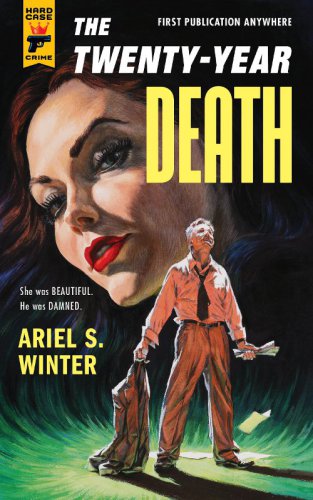
The Twenty-Year Death
The Twenty-Year Death Series, Books 1-3
کتاب های مرتبط
- اطلاعات
- نقد و بررسی
- دیدگاه کاربران
نقد و بررسی

June 11, 2012
This isn’t a first novel so much as a series of three discrete but interrelated first novels, each written (with apologies from the author) in the style of a different iconic thriller writer—Georges Simenon, Raymond Chandler, and Jim Thompson, respectively. This is a bold, not to say supremely cheeky, conceit—and if Winter hasn’t completely channeled the hard hearts and gimlet styles of these dark, departed legends, the good news is that he delivers something even better: a hell of a lot of fun. The noir triptych is nominally linked by the presence of an alcoholic (but of course!) American writer, Shem Rosenkrantz, who remains largely—if menacingly—in the background for the first two installments before emerging (in first person) center stage in the last, best story. Set in the fictitious Verargent, France, circa 1931, the first book, Malniveau Prison, revolves around the mysterious death of a prisoner—the father of one Clothilde-ma-Fleur Meprise, Rosenkrantz’s beautiful wife. (Along the way, some children—and Clothilde herself—go missing.) The search for the killer leads to a mysterious psychopath with a penchant for torturing tots, as well as a coverup at the titular prison. In the second, The Falling Star, set in 1941, Rosenkrantz is a womanizing L.A. screenwriter on a self-destructive slide. His wife, now working under the name Chloë Rose, is a successful but unstable starlet who suspects she’s being followed. A suitably laconic Chandlerian PI, Dennis Foster, is enlisted to help the troubled star—but is he really being set up for a homicidal fall? In the third, and arguably darkest, tale, Police at the Funeral, it’s 1951 in Calvert, Md., and Rose has been institutionalized, leaving Rosenkrantz—now a remorseful has-been—roiling in the tide of his boozy dissolution. “Yeah, I’d always gotten a raw deal, and I was too pathetic to do anything about it, and I hated myself for that” pretty much sums up the self-inflicted purgatory this antihero wallows in. The stories work wonderfully well individually, but taken together create a tapestry of associations and reflections, sort of like mirrors trained on other mirrors. The whole, as they say, is greater than the sum of its parts. Along the way, Winter manages to deliver more than a few winking nods to genre tropes without ever descending into the arch or the obvious. Though there’s clearly something meta (not to say postmodern) about the whole endeavor, Winter never loses touch with his genre heart; the books practically radiate grassroots passion. No, he does not entirely capture Chandler’s verbal color or masterful use of metaphor (but who does). Nor does he completely conjure up Thompson’s furious fusion of horror and hilarity (but who does). He comes damn close to capturing Simenon’s slick, spare procedural vibe. But in the end all these comparisons are, yes, odious—because Winter has created something more than a facile feat of literary ventriloquism. He has written a truly affecting and suspenseful triple treat that transcends the formal gimmick at its heart. Agent: Chelsea Lindman, Nicholas Ellison Agency. (Aug.) Reviewed by J.I. Baker, who is the author of The Empty Glass, which Blue Rider Press will publish in July.

Starred review from September 1, 2012
This debut crime novel comprises three sequential novels (set in 1931, 1941, and 1951) revolving around the American writer Rosenkrantz and his beautiful, troubled wife Clothilde and written in the noir styles of Georges Simenon (1903-89), Raymond Chandler (1888-1959), and Jim Thompson (1906-77). It is a major accomplishment for this first-time author to effect three stylistic forms. But Winter does an extraordinary job. In Malniveau Prison, bleakness and despair pervade a grim prison in the French town of Verargent as numerous prisoners are murdered, including Clothilde's father. This precipitates a breakdown presaging her mental fragility in the subsequent stories. Falling Star is set in San Angelo (Los Angeles, probably), where Clothilde (Chloe) is starring in a movie, Rosenkrantz is the screenwriter having an affair with Clothilde's costar, and Foster is the investigator who solves the murder of the costar. The final novel, Police at the Funeral, is the most impressive and disturbing. Rosenkrantz leads a dissipated existence and Clothilde is in permanent psychiatric care. After accidently killing his son, Rosenkrantz commits multiple murders to conceal this act. Rosenkrantz's internal narration in which he justifies yet despairs over his actions, is compulsive reading. VERDICT A brilliant evocation of three distinct masters of bleak noir fiction, handled deftly with panache.--Seamus Scanlon, Ctr. for Worker Education, CUNY
Copyright 2012 Library Journal, LLC Used with permission.

Starred review from May 1, 2012
Hard Case Crime originals are notable for capturing the feel of pulp classics without slavish imitationwhich makes this first novel somewhat unusual. Winter, a literary detective and former bookseller, tells an epic tale in the form of three novels written in the style of three different crime-fiction legends. Book 1, Malniveau Prison, channels Georges Simenon as Chief Inspector Pelleter tries to deduce how a murdered prisoner escaped the prison walls. Book 2, The Falling Star, is the Chandleresque story of a private eye, Dennis Foster, who's hired to reassure a paranoid movie star and maybe take the rap for a murder. A recurring character in both books is Shem Rosenkrantz, an American writer who first seeks seclusion in France and then squanders his talents in Hollywood. In book 3, Police at the Funeral, Rosenkrantz takes over the narration with the voice of a washed-up Jim Thompson protagonist, and, as he unravels, we see how the stories are stitched together. This is audacious and astonishingly executed. Winter understands the difference between mimicry and interpretation and opts for the latter, capturing the writers' voices, not merely their vocal tics. What might seem at first like an amusing exercise for crime-fiction buffs becomes by the end immersive, exhilarating, and revelatory.(Reprinted with permission of Booklist, copyright 2012, American Library Association.)

























دیدگاه کاربران